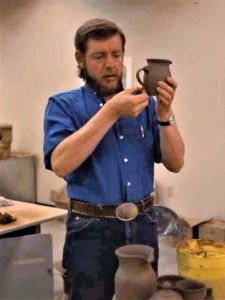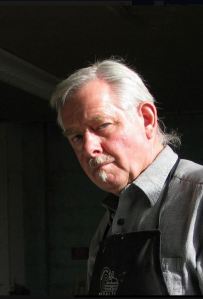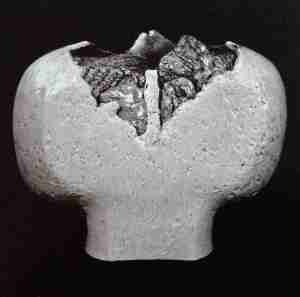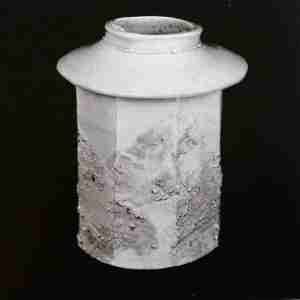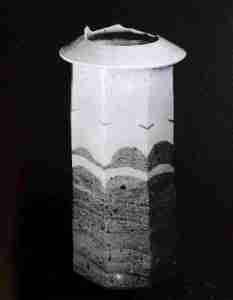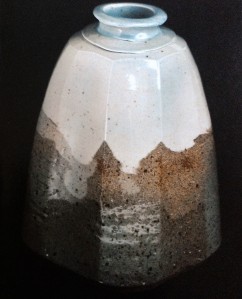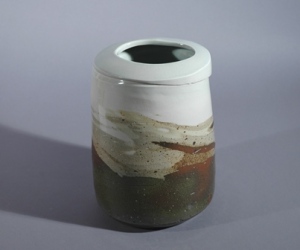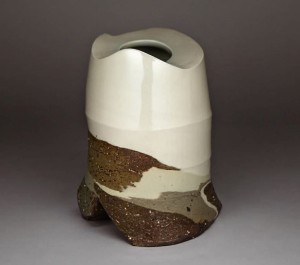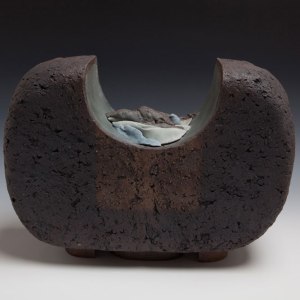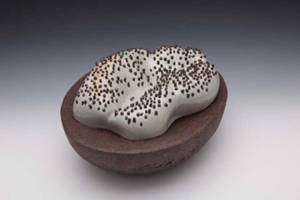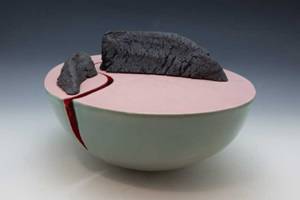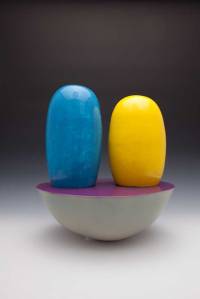Capsule
Dates: 1944 – 2020
Production Dates: 1966-2017
Location: Calgary, Banff, Medicine Hat, Alberta
Types of Work: Functional, Sculptural
Preferred Kiln Type and Firing Process: gas, reduction; high and low firing.
Preferred Clay: stoneware, grogged and stained; porcelain
Signature/Mark/Chop: In his early years at Ceramics Arts Calgary Les had to use the standard impressed factory mark; however his name, “MANNING,” can be seen on an ashtray base, handwritten in a blackish ink after firing.
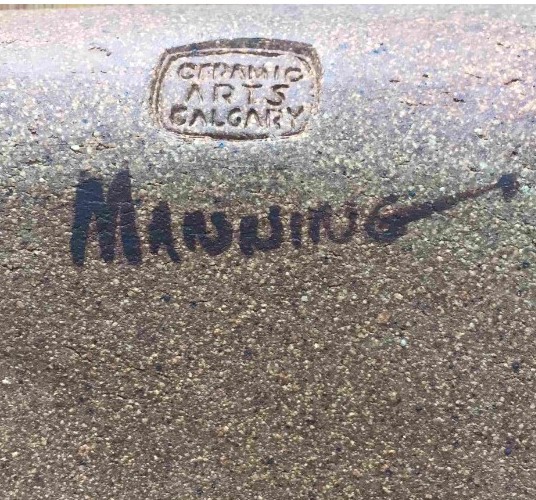
Later, Manning will often use a cartouche-like mark on the side neat the base and sometimes combined with his signature and date inscribed on the base.
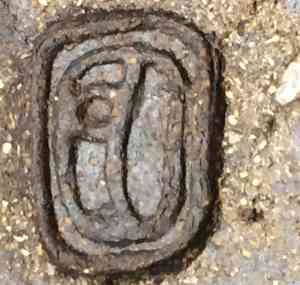
Biography:
When I think of Les Manning the words ‘International Albertan’ keep popping up. Why? Les was a country boy from Provost, Alberta, riding a horse in his early years to go to school, and spending most of his career in his home province of Alberta. Yet Les Manning has made Canadian studio ceramics internationally recognized and has brought international studio ceramics to Canada like no other artist or educator. Unlike other major artists who brought their talents and inspiration from England, Europe, the United States or Japan, Les in his art remained true to Alberta. What he introduced into Canada from abroad and how he introduced Canada to the world were, and still are, transformative.
How did a boy riding by horseback in grades 1 and 2 to Twin Lake country school² end up a major Canadian ceramics icon?
Firstly, he was a typical teenager:
“I had no place or goal, just looking for a totally different experience.” ¹
Calgary
Fortunately, several years later in Provost, Alberta, his school teacher, Ruth Auburn, recognized his artistic talent in grades 7 and 10, and personally drove him to the Alberta College of Art (ACA), in Calgary to register. He was seventeen years old. ²
It was 1962. Initially he wanted to be a painter,¹ to be a Charlie Russell (the early 20th century American western painter) but by his second year he had discovered ceramics in a general crafts course.¹ Perhaps a personal memory helped inspire the shift:
“I remember, as a young boy, being aware of finding shelter from the wind. I believe this influenced me to spend a lifetime beside a warm kiln.” 12
Also, there was something more aesthetic about the attraction of clay:
“While sitting painting I kept thinking about what I could do in clay. The 3D quality of clay was its biggest attraction. The manipulation of media was so easy. … The excitement of the 3D quality was the deciding factor.” ¹
And:
“Coming from rural Alberta, functionality was a big part of our culture.” 7
With Walt Drohan as his instructor he graduated from ACA in 1966.
Les is modest about his success, however:
“ I was one of the luckiest people. I have had the most fortunate set of circumstances and opportunities keeping me in the business anyone could wish for. Almost too fast. … I was in the right place at the right time.” ¹
The start of his professional career soon followed when Drohan arranged an apprenticeship in Ceramic Arts in Calgary from 1966-68.¹
“ Walt made arrangements for me to work three days a week. I went to school for two days in my fourth year. The work on site was a credit for ceramics. … It was an interesting situation. I wasn’t apprenticed to anybody but apprenticed to a studio.” ¹
Ceramic Arts was a starting place for a number of potters. There was much technical sharing beyond the academic:
“[Luke Devries], a master potter, was there. I did most of the glazing and decorating.” ¹
Les continued working there after graduation, staying overall about two and a half years. ¹ He learned further studio skills with the return of John Porter who had been working with Sunburst Ceramics in Medicine Hat, Alberta. Ceramic Arts provided much “bread and butter” business such as ashtrays. Through Porter Les was to learn about time studies essential to production in a studio,¹
Inevitably the routine began to tell on Les. Another opportunity was to conveniently arise. The door to education opened.
“Katie Ohe was commissioned to do a large mural for the University of Calgary and couldn’t continue her ceramic classes at the Allied Arts Centre in Calgary. She visited to pick up materials at various times. We had interesting conversations. She knew me as a student at ACA and was interested to take over her class. So while I was working I was teaching at the Allied Arts Centre.” ¹
Les taught at the Centre, from 1968 to 1969. When the Centre ran into financial difficulties he negotiated and set up Manning Ceramics. Part of the arrangement was to keep the Centre facility in reasonable shape by keeping the heat and lights on while he taught ceramics.¹ He was busy: adult classes four days and evenings a week and children’s classes on Saturdays.¹
He ran this operation from 1969-74. The classes paid for themselves. But there was no work in the summer, and there was the inevitable pull of the need “to be an artist.” ¹
“With the arrogance of art school I was beginning to feel the production situation and repetitiveness of the Centre was beginning to hold back my talents. … I enjoyed the personal contact with the students but wanted to test my own abilities.” ¹
Les freely acknowledged this struggle between the need to create and the need to teach throughout his career.
At this time he still wanted to remain in Calgary. 1
Banff
The catalyst that kicked Les’ career into overdrive and eventually cemented his reputation was an invitation to teach summer classes from Vic Brosz who was on the board to improve classes at the Banff Centre.¹ Les’ was to stay from 1971 to 1995. The Banff Centre was transformed from a Summer School into an internationally respected Artist Residency Program. He taught summer school and winter high school community classes from 1970-72; was artist-in-residence (AIR) from 1973-74; and Director of the Ceramic Studio for twenty years, from 1974-94. A Senior Artist-in-Residence position from 1994-95 allowed him an opportunity to truly focus on his own clay work This period and Banff were the bedrock of his success.
But there was to be more accomplished during this period.
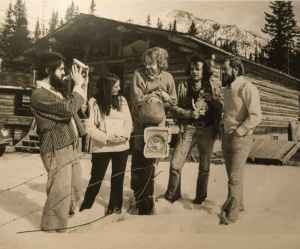
Les’ first involvement with his Banff teaching was winter commuting from Calgary to Banff. He realized he had to make a decision: to keep his studio in Calgary or to pursue full time work in Banff, and to design a brand new studio space for the school. He had seen Drohan design such a space at ACA, and was excited by the challenge. ¹ He moved his equipment to a new studio space in Canmore, just outside of the Banff National Park gates. He co-founded Stonecrop Pottery in Canmore in 1973-74 with fellow artists Tony Bloom, Bonnie Lebowitz, Bart Robinson, and later, Robin Sturdy. Their first location was a log building.10 The studio-workshop was a success but over the next four years Les felt he didn’t have the time to participate and that he was acting more like a landlord, Gradually he left much of the group’s administrivia to his partners, himself focusing on other activities.¹
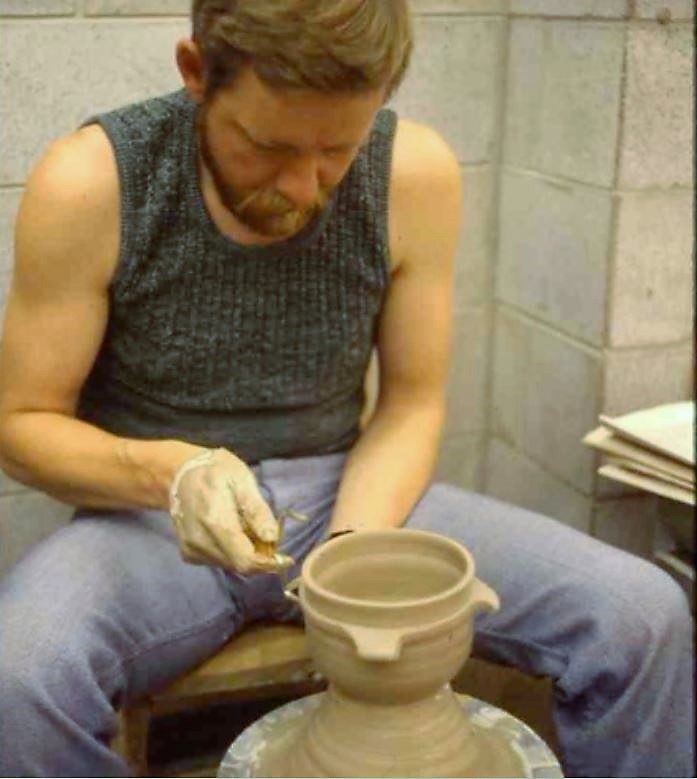
The Banff experience was exciting for Les. Here he was given the opportunity to bring in top Canadian and International ceramists to work with top Canadian and international students. The experience was so different from his student days at ACA where he had only the one instructor, Walt Drohan. This led to his basic philosophy for the Banff Centre ceramics program:
“… not to be bounded by an academic framework; to be a totally professional clay experience..” ¹
“One of the most important things I’ve learned is the value of bringing people together in a supportive environment,” he says. “These encounters bolster people’s faith in their own ideas, help nurture their concepts, and encourage the exchange of ideas. … By removing the demands of home life, regular responsibilities, and the pressure of financial issues, artists find they are free to explore, discover, and create. It can be scary, but it is an invaluable experience.” 7
It took time for the Banff programme’s student numbers to increase. This left Les with time to travel and start other activities. Below is a summary list of his Canadian and international organizational activities over the years. His exhibition, jurying and consulting activities would fill many more pages:
- 1971-3, President, Alberta Potters’ Association (APA)
- Chairman, International ’73 Exhibition and Conference, Banff/Calgary, for the APA under auspices of the IAC.
- 1974-5, First President, Canadian Craft Council
- 1979-80, Founding Member and Vice-President, Alberta Crafts Council (ACC)
- 1982-4, Chairman, Canadian Clay Conference ’84
- 1985-8, Board Member, Craft Working Committee for ’88 Winter Olympic Cultural Organization Arts Festival
- 1986-8, President, Alberta Crafts Council
- 1988, Spokesman for Canadian Craft Council at the World Craft Council Assembly, Sydney, Australia
- 1990, Nominated to the Board of Directors of the International Academy of Ceramics
- 1992, Member of the Council of the International Academy of Ceramics, representing Canada
- 1994, Vice President International Academy of Ceramics, representing North America
- 1999, Nominated for President of International Academy of Ceramics (IAC) 5
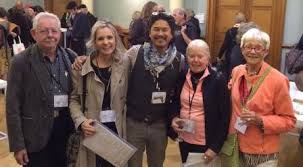
Les spoke proudly of his stay as the APA president when he helped change regional ceramics to an international level. He was particularly proud of the International ’73 exhibition and its impact in bringing new insights on international art to Alberta and Canada. It was a difficult venture. Les confessed:
“But that’s what ignorance can do, sometimes putting you into very exciting spots. Ignorance in that we didn’t really know what we were embarking on, but it put the Alberts Potters Association right out front. We were flying by the seat of our pants. It introduced international ceramics into western Canada. And introduced new ideas in terms that clay didn’t have to all be reduction stoneware thrown on a wheel. It started a lot of working with other materials, porcelain, low fire temperature clays. Maybe that was inevitable but it was a good shot of inspiration.” ¹
Three years later, in 1976 with the APA’s National Ceramics Exhibition at the Glenbow, Calgary, he was able to make learned corrections and adjustments. ¹
But all this activity was new for Les, and the positive feelings didn’t come easily, or at the right time. The success of the exhibition led to his term as the first president of the Ottawa-based Canadian Craft Council. He said:
“It was a most difficult time for me but it was the most stretching thing I’ve ever done [up to 1981]. I found how little I knew about the craft scene across Canada, and my inability to speak, to being a publicist, a diplomat, … and putting things on the chopping block. I had a board of twenty one crafts people each with their individual and craft agendas. After coming out of that it was almost like a two year depression, sorting out how you would do it if you had the opportunity to do it again. ” ¹
To help publicize the Craft Council he did twenty four workshops across Canada. ¹
Even in 1981 Les was reflecting on the pros and cons of his career path and the effect it was having on his art:
“Perhaps I have let the skill of my hands fall away but not my aesthetics.” ¹
1994 was a turning point for Manning with a one-year senior artist-in-residency at the Banff Centre. This was now his time to concentrate full-time on his own creations. The body of work he produced formed the exhibition Nordic Ode, presented by The Banff Centre in 1995.
In 1997 Les was awarded a Canada Council Artist ‘A’ Grant to complete a cycle of work that has been in production for over 20 years.
After a six year period in in Elginburg, Ontario, just north of Kingston, where landscape continued to be reflected in his work, Les returned to Alberta.
He returned to Medicine Hat, Alberta, to Medalta, where he was essentially to remain for the rest of his career. Once again a prairie boy. He was a visiting artist in 1998 (one of the first artist-in-residence programs) in Medicine Hat. Since he had developed studios in Calgary, Canmore and Banff he accepted a three year project to build a state-of-the art contemporary ceramics studio facility. The project, the Shaw International Centre for Contemporary Ceramics, took nine volunteer-years. A three hundred square foot art gallery at the entrance to the centre was named in his honour.6 He was also to work as Artistic Director for Medalta.5
To follow through on my initial statement of Manning as ‘international’ his involvement in professional and other organizations is extensive to say the least. He has traveled to more than 46 countries for ceramics-related activities.7 His list of international sabbatical studies confirms this impression: Australia, Thailand, China, Korea, Japan, Hungary, Italy, Switzerland, Austria. California, Greece, England, Israel, and Uzbekistan to name only a few.
Katherine Wasiak comments:
“On almost every continent you can find an artist whose practice has been directly influenced by Les’s gentle guidance. … Les influenced a generation of artists who have gone on to advance the field through exhibition, education and advocacy.” 8
Formal recognition of his contribution to Canadian ceramics was capped when in 2011 he was awarded the Order of Canada and the Queen’s Diamond Jubilee Medal in 2012.
Yet Les Manning remains modest about his achievements while stating firm in his goals:
“In many ways I fell into things more than got there by having great knowledge . . . but I do have a great passion. I think my real contribution is in the area of community service. I want to keep ceramic arts in the public eye and get the word out about its value.” 7
In 2017 Les Manning retired for medical reasons. He passed away February 2020.
Gallery:
In looking at Les Manning’s works below one might be forgiven for thinking one is looking at a few different artists. Although he is mostly known for his mountain landscapes, his immediate inspiration at the time, there is a strong thread of memory, of roots, in his work. His later years give full expression to this side. In talking with him many years ago Les never forgot his origins, his own roots.
Early Works
In these early works Les shows at first an industrial then an “academic” side with transitions in subject and clay handling.
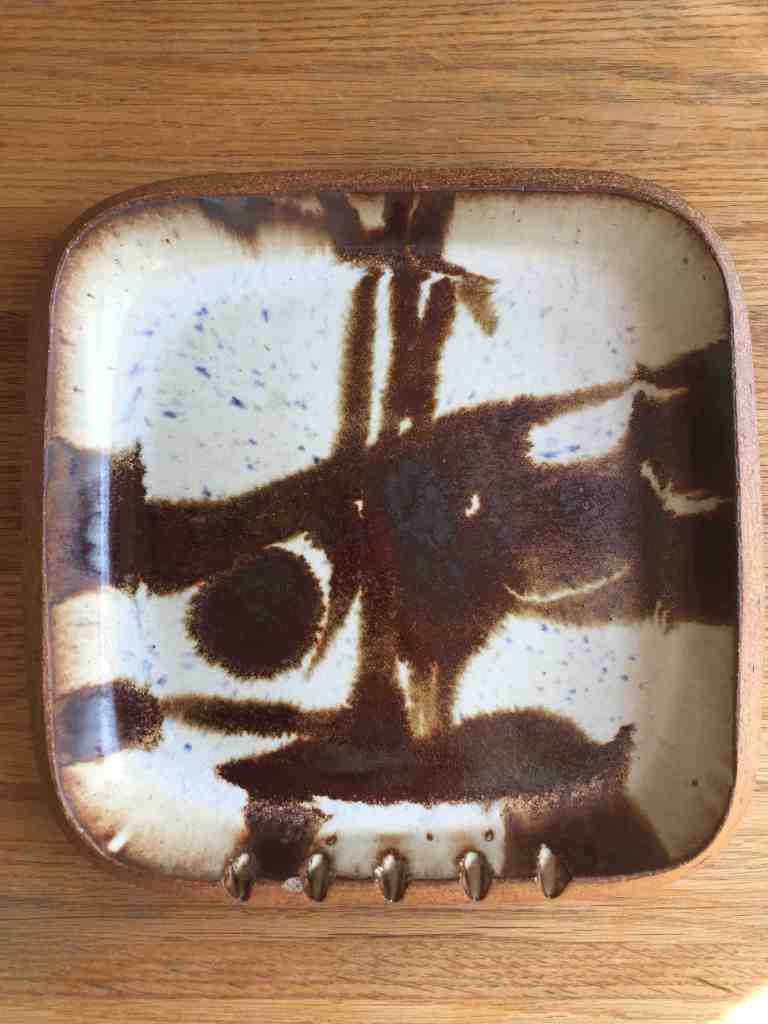
Ceramic Arts Calgary Ashtray,1966-68. Working at Ceramic Arts helped Manning survive but it also helped tighten his clay and glaze handling for later years. Although he had to adhrere to form he was able to add his own splash of energetic clay design.
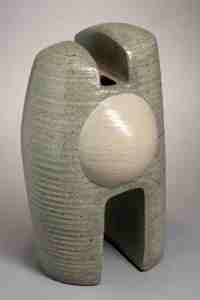
Les’ early Untitled sculpture from 1973 is an interesting piece. An early sculptural outlier and perhaps even formally a precursor to his Common Opposites of recent years it does not carry the emotional and nostalgic content of these recent works. There is a simplicity of forms and surfaces: a hollow, thrown form, now cut to an “H” shape with an attached hemi-sphere. It is an “art work”, a sculpture, but still showing its throwing marks. Although tightly controlled the two clay types already show Manning’s interest in clay combinations.
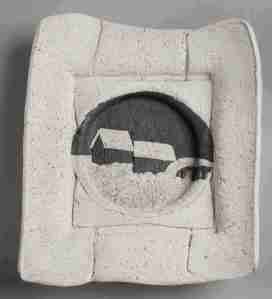
Winterscape #1, 1975, is a landscape painting in ceramic. Here Manning has designed a small domestic landscape tondo, set within the “canvas” of a square plate. The scene is a circular vignette a landscape, of snow, rural with houses.
Tony Martin in his Ceramic Arts and Perception article noted that “For his first few years in Banff Manning felt uncomfortably claustrophobic, with his customary lines of sight obstructed in every direction:
“When you take a prairie boy and put him in the mountains – that is scary. I took a long time to be comfortable.” 16
“The mountains are my spiritual home, … Regardless of where I live. … Oddly, when I lived on the prairies I worked vertically, then in Banff I stopped throwing pots, built slab plates and worked horizontally.” 7
Les’ Untitled, sculpture from 1977 hints at possible emerging directions. The visible mountain forms were not the only ones in Manning’s transition. The work is dynamic in its surface and pedestal base. Tectonics play their part. The pitted oval sculpture—a form we shall see later in Common Opposites—cracks open as though split by some orogenic force, providing an upward thrust to balance the lateral spread of the work. The whole bubbles with energy, from the rough surface of the fractured shell to the roiling masses of mountain, batholith and dyke forms.
Vase with mountain landscape. is a functional work. The hexagonally shaped vase is covered in a misty mountain landscape with a heavily textured mountains that look “painted on” in a grogged impasto. The body is capped by an smooth, extended roof-like ”lid” that slopes up to a more casually surfaced rim. Already Manning is playing with his varieties of surface texture and form.
Les’ Untitled vase from 1977 goes a step further. The landscaped clay is not a just surface feature; rather, separate clay layers are stacked like a drilled core sample, a stratigrapic column shown as rounded hill forms. The vase shape itself is cut or beaten, again to an hexagonal shape. Simple bird-like v-shapes form a line above the hill tops. The sharply edged rim is more obviously distorted .
Fluted Bottle, 1978, shown in the 1978-79 exhibition Clayscapes, shows a further progression in Les’ oeuvre. The scalloped shape is more massive with a broader horizontal play of lines and forms. Still a functional work there is now a more aggressive layering and intermixing of differing clay colours and textures. The mountain scene is still quite literal with the white upper body showing as sky rather than as the snow layers of later works.
Mountain Landscapes: “A Sense of Place”
Manning’s mountain landscape forms are his best known style form. Before we look more closely at them the following is a summary of his approach from his artist statement and elsewhere:
- “I choose to work the way I do in order to produce an abstraction of the Rocky Mountain landscape.
- I create work that plays with space, light, and shadow within the sculptural landscape. The dark base clay of granite and perlite animates the surface as foreground. The lighter stonewares give a sense of midground and offer a transitional area from dark to the lighter porcelain. This last surface is the background / distance of snow and high elevation.
- Included are punctuations of color: pink – like the edges of the snow in the winter sun, green – like the color of the lakes and streams, yellow – for a touch of the fall Larch colors, and blue – for reflections on the snow and the transition of water colors.
- The celadon glaze is used, as it is the color of the lakes and streams.
- The sand blasted surface makes the clay more responsive to light change and animates the surface of the works.
- Gathered together and placed right these give a landscape that you can visually walk into. Technically, this work goes against the conventions of clay practice since the clay bodies shrink and fire differently. In a practical sense the technique is over challenging and complex, much in the way the landscape itself was formed.
- I also reference an age-old way the Chinese and Japanese used to support valued pieces through the use of silver amalgam in the stress fractures that form from the test of the firing – these are not structurally problematic. So, something borrowed. ” 5
- “My work is strongly connected to the landscape; I find elements in these surroundings which I bring to the ceramic process, so that it becomes easily accessible to the viewer.
- “On making these vessels, the main concept is to capture the larger space of the landscape and have it contained in the smaller space of the vessel.
- “I find inspiration in the dynamic uniqueness of the Rockies, … I’m particularly attracted to the high country above the tree line and the natural forces that formed it.” 7
A Vic Brosz article in a June, 1982, Ceramics Monthly illustrates some of the steps of his clay handling. 17
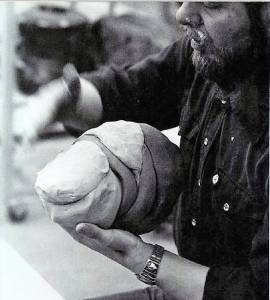
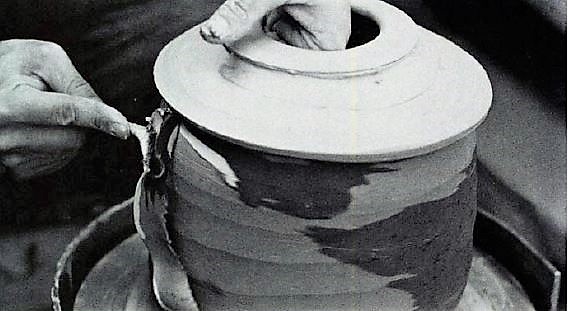
In these images of Manning’s early and late stages in creating a mountain landscape there is an element of the random. The landscape is not a copy, rather, an expression, a feeling using the constraint of the vessel as a painter uses the boundary of the canvas. Sometimes a specific time and place may be suggested in the title, sometimes just a seasonal or time of day is enough.
Katherine Wasiak notes further surface treatments Les uses:
“The surface is sandblasted, reducing the sheen and leaving the glaze to pool in areas. He adds silver amalgam to small stress fractures, creating flashes of light reminiscent of sun on water. In recent works, Manning has incorporated elements that reflect the impact of humanity on his beloved landscape, imprinting subtle arches and lines into the clay.” 7
Alpine Spring, 1985, shows further developments with an overall softer, rounder form and the opening up of a wider lip folding in on itself. The energy of the clay layers is now more evident, their shapes and colours now dominant. A subtle shift. Although mountains the overall effect is of a horizontal, massive stability cut by diagonals of colour and texture.
In spite of years of success in his various ventures Manning still held doubts as to the reception of his works when he exhibited in eastern Canada.
“I was sure people were watching me and wondering who was he copying now, because we had all these famous people there (at The Banff Centre) and it just bugged me because I thought they were going to say this looks like so and so, … So I went to the landscape and made these technically complicated things and I didn’t realize there are not as many people who go to the mountains as us in Banff and Canmore do, so I was expecting Toronto city people should be able to look at an exhibition and fall all over it. But they had never been up in the high country and what did it mean to them? It was just colour smacked into clay and odd shapes.” 11
Rundle View, 1988. Once in the Claridge Collection this work shows Manning’s skill with a deliberately limited palette of whites and browns. He plays off the smooth whiteness of porcelain against the dark, grogged stoneware. Subtle shifts of colour are streaked between. The base has a carved cut. The lip is an undulating wave of white, like snowdrifts. Yet it is still a pot with the subtle but precise shift, a narrowing at the waist. The smoothness of the surfaces, even the grogged, are a contrast with the reality of the fractured and eroded reality of snowy, forested mountain peaks as Manning plays with the landscape as vessel.
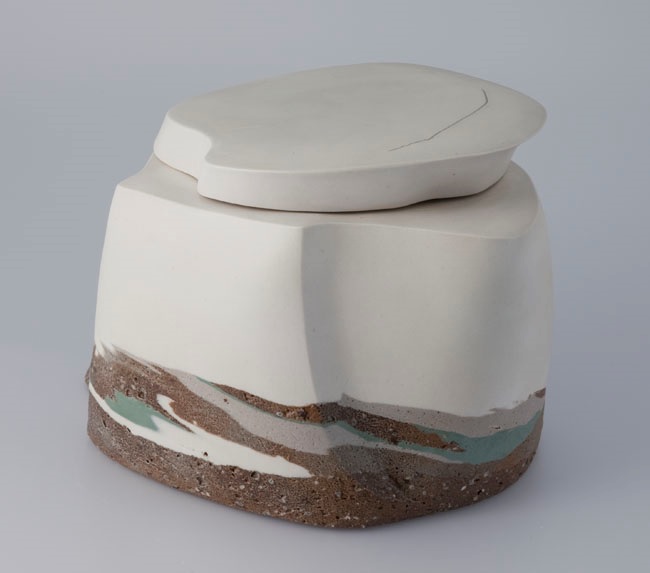
Glory Pass, 1998. Here in a lidded form Manning has added more colour with streaks of blue and green. The grog and colour are limited to the lower quarter. The shoulder is now a sharp angle. The rim is covered by an asymmetrical lid with an overhang like wind blown snow streaking off the mountain top. Sharp angles, ridges, are cut into the body. We have seen this in earlier works where the body is scalloped and cut.
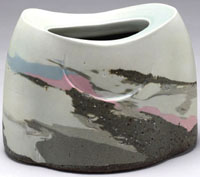
Sun Up/Sun Down, 2007. Here Les is depicting a time of day rather than a place. In such works Manning shows his skill in balancing clay form and colour pattern. The browns, pinks and blues have an energy that is almost expressionist: coloured clay layers swirl as though in a vortex, showing the both their original hand layering and later wheel thrown treatments. The shape is simple, a deformed cylinder and rim. save for a slight arc cut into the side, a mere nick in the clay layers, catching the eye like a glint of sunlight, or a reflection off snow.
An Overseas Example: China
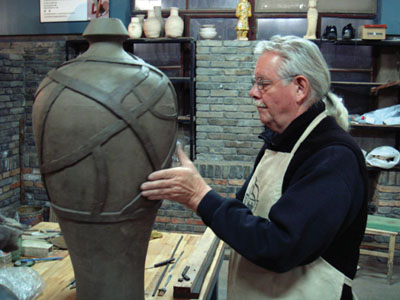
Les has visited more than forty six countries in his career. Some such as Uzbekistan stand out in his mind but the one that temporarily changed his subject and style was China.
Katherine Wasiak in a Gallerieswest article describes the project:
‘[The] project involved organizing a team of … Canadian potters for a residency and exhibition for the official opening of the Canadian Museum at the Fule International Ceramic Art Museums in Fu Ping, China. “We were challenged to work with industrial Chinese clay and glazes, and explore the intersection of our art practice with Chinese culture,” he says. “We left a legacy of almost $200,000 worth of art to start the Canadian collection.” Manning adds that the Canadian Museum is among 12 national museums on the site open in time for the 2008 Olympics. The plan is to establish residency opportunities in China, which will add to the permanent collection.’ 7
War Horse, 2007. The work reflects the influence of China, the host country. The work is metallic in form and glaze. The horse heads are naturalistic, an unusual feature for Manning. Artist Grace Nickel describes the significance of the project in her blog . The other artists included in this major project besides Manning and Nickel were Sally Michener, Susan Collett, Jim Thomson, Katrina Chaytor, Ann Roberts, Ann Mortimer, Gilbert Poissant, and Charley Farrero.
Common Opposites
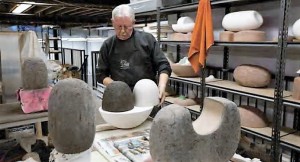
Interestingly, when given the chance to stretch himself a few years later Manning produced the works for Common Opposite, a travelling exhibition curated by Joanne Marion, Curator of Art, at the Esplanade Arts & Heritage Centre at the City of Medicine Hat.
Marion writes of Les’ approach in the exhibition catalogue:
“In a bold departure from the practice which the internationally renowned ceramist developed and refined over the last two decades, the 19 sculptures in Common/Opposites combine Les Manning’s expertise and skill as a ceramist with passion and playfulness. Manning’s new works show a rich emotional and metaphorical register while drawing deeply upon his personal experiences and knowledge of Canada’s lands. Juxtaposing forms, textures and colour, Manning evokes the monumental reach of modernism as an artistic endeavour. Playful references to the humble objects of everyday lighten his sophisticated and contemporary appreciation of the more base aspects of nature, to reveal the rich and contradictory poetry of our ordinary world.” 9
Manning returns to his deeper inner self as an artist, not as mentor, teacher, or administrator. He returns to subjects with deeper personal roots from early years. One could be excused for thinking these works below are by a completely different artist. Perhaps in terms of timelines they are. Subject-wise these are not the works of an observed, consistently developed progression or evolution; rather, they are almost explosive expressions of long suppressed, perhaps even repressed, inner impulses that had been constrained by the forces of mentoring, teaching, networking. There is a return to earlier days: to prairie boyhood memories, to a young artist developing as sculptor.
“I’m now learning how to do it with a bit more grace and thoughtfulness. That has allowed me to use a very different kind of form that puts it into the sculptural realm, so the other work did not have a clear possibility of critique. These now are in the guidelines of how you think and talk about sculpture.” 11
Joanne Marion also mentions a practical reason for Manning’s shift in style: the quality of the clays he used was declining as the source strata were mined. The failure rate in his firings was becoming too high.9
Technically though Les exploits his skill in clay handling and firing. In the exhibition catalogue he describes the clay and firing details used:
- “The clay materials are coarse textured stoneware, dark brown to black in colour, with granite, (mostly feldspar) and perlite, which give a rough, earth-like surface.
- “I also used porcelain and some smooth stoneware to give colour and a smooth finish.
- “Most of the textured clay has little glaze but the porcelain areas are glazed with a celadon surface.
- “These are high fired in reduction in a gas kiln at cone ten (2350 F.).
- “Other similar clay bodies in the medium range as well as low temperature are fired in oxidation in an electric kiln at cone 6 (2232 F.) as well as cone 06 (1830 F.) for the bright colours, which can also range into the higher temperatures.“ 9
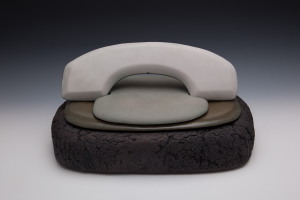
Land Line, 2011. Les comments on the meaning of this work in the videos below. It is a direct reference to his early rural prairie years, before the age of cell phones. At that time phone lines were strung along barbed wire fences to provide service. Using a ‘newer’ form of clay layering, cleanly stacking layers of differently coloured and textured clays, he creates a recognizable image of an old phone with just the simplest of shapes. Compared to the colours of other works in the exhibition this work is monochromatic.
Prairie Cut 1. Here a heavily grogged, dark brown “egg” serves as foreground and frame to a distant mountain landscape. It is though one is looking through a prairie channel or slough through to a distant montane vista. The mountain snow and lakes are familiar, smooth blues and whites, backed by rough dark brown. The cut itself is a clean, glazed semi-circle, a concave negative space, a counterpoint to the mass of brown clay curves. The whole rests on a barely observed tri-partite base.
Declining Nude, 2011. Although the title suggests a figurative subject Manning continues the landscape theme. Here Manning presents an aerial view of a forest of stumps, denuded by clear cutting, a political statement on lumber industry practices. The colours are simple brown and white The forms are smooth, rounded, except for their precise edges. The snow covered stump-forest flows in softly lobed hills and valleys until it meets the hard flat surface of the minimalist brown base. Brown and white, layered clays are presented in a new format. The aerial view is in contrast to his earlier mountain landscapes which were depicted from a horizontal viewpoint.
In Red River/Pink Plateau, 2011, on a sharply cut hemi-sphere base Les has created a minimalist landscape, with a similar aerial viewpoint as Declining Nude. The flat, matte, surface is topped by two craggy, black rocks that emerge as eroded, glacial erratics upon the unnaturally flat, pink plain. The plain itself is cut sharply and cleanly by a meandering red river, a red that seems arterial in hue. The juxtaposition of surfaces, textures and colours produce a Zen-like simplicity.
Carnival, 2011, exploits Les’ use of colour further. Formally, Carnival is similar to Red River/Pink Plateau above: a coloured, hemi-spheric base and two emerging forms. Yet the effect is so different. Yes, there are the smooth surfaces and sharp edges but the colours, gloss and positioning create a different effect. The colours are a vibrant play on primaries, their glossy surface catching their reflections and playing with the colour shifts resulting. This is the only potential mixing of their hues; otherwise, the colours on each element are clean, no mixing. Each form is a combination of smooth roundness and sharply cut edge. Manning plays with them as sculpture: the large blue and yellow balloons rest firmly on their bases on the rounded hemi-sphere. While one’s eye is attracted to the blue/yellow/pink contact one has to take careful notice of the subtle negative space between the blue and yellow balloon shapes as it swells and narrows, creating an almost magnetic attraction.
In spite of the visual differences in his art over the decades Les Manning has remained firm in his inner artistic core:
“As a person’s experience grows it’s important to be more direct, removing indecision and questioning, and to be confident and united with the material – not disciplining it, but sharing the clay’s expression. I feel all things are related, even the conflict between the formal and the informal which I attempt to bring together in my work. This is highlighted by form and with textures of clay related to my life experience as well as the natural environment.” 12
Links to Sites for More Works:
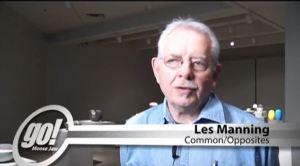
Common Opposites at the Moose Jaw Museum and Art Gallery. A Youtube video produced . Shaw TV Moose Jaw. published June 2014.
Common Opposites, at the Seymour Art Gallery North Vancouver. This video, filmed on March 24, features excerpts from the artist talk.
Stonecrop. CanmoreArts Events. October 2014. An informative and sometimes amusing history of the development of Canmore’s Stone Crop Studio. 6:11 min.
Les Manning Works Are Featured In The Following Publications
- Books: Ceramic Spectrum, Robin Hopper, Canada; Ceramic Technology for Potters and Sculptors, Yvonne Cuff, Australia; Studio Ceramics in Canada, Gail Crawford, Canada; Contemporary Studio Porcelain, Peter Lane, England; World Famous Ceramic Artists Studios – Volume 1, Bai Ming, China; Forward: Made of Clay, Ceramics of British Columbia, Potters Guild of British Columbia.²
- Periodicals: 1982/95 Ceramic Monthly; 1985/95 Contact – Ceramics from a Canadian Perspective (National); 1995 Ceramics, Art and Perception; 2002 Contemporary Ceramics – China; Ceramic National – Korea; Ceramic Review – Taiwan; 2002 Ceramic Art – Taiwan. ²
Major Collections
Alberta Foundation for the Arts Collection; Alberta Culture; Alberta Potters Association; Glenbow Museum; Jean A. Chalmers National Craft Collection; Museum of Canadian History, Hull, PQ; Peter and Jeanne Lougheed Collection; The Tennessee State Arts Board Collection, USA; Siklos, Baranya Creative Colonies, Siklos, Hungary; Koffler Collection, North York, ON; Massey Collection, Museum of Civilization, Ottawa, ON; Pecs City Museum, Hungary; The Appalachian Centre for Crafts Collection; Aaron Milrad Collection, Toronto, ON; Bechyne International Symposiums Collection, Czech Republic; The Whyte Museum of the Canadian Rockies, Banff; The Banff Centre for the Arts, Banff; Canadian Clay and Glass Gallery; Metropolitan Museum of Art, Seoul, Korea; Fukaoka National Museum, Saga prefecture, Japan; Private collections worldwide.
Endnotes & Bibliography:
- Les Manning Interview with Barry Morrison. February 22, 1981.
- The Provost News. Noted Artist Les Manning Earns Award of Honour. November 5, 2008. newspaper article.
- Lachapelle, Safire. Les Manning. Medalta Newsletter. Not dated.
- Governor General of Canada website. Les Manning Page.
- Willock and Sax Gallery Banff, AB. Page on Les Manning.
- Medalta Online Newsletter. Les Manning Gallery. 2017.
- Katherine Wasiak. Les Manning – Homage. Galleries West. August 31, 2008.
- Safira Lachapelle. Medalta Online Newsletter. November 19, 2012.
- Joanne Marion. Common/Opposites. Catalogue of a touring exhibition organized by the Esplanade Art Gallery, Medicine Hat, Alberta. Essays by Joanne Marion and Elaine Olafson Henry.
- Mellors, Siobhan. SPOTLIGHT ON THE ARTS: Stonecrop Studios: Highline Magazine. Tuesday, May 30, 2017.
- Alexander, Rob. Manning inducted into Order of Canada. Rocky Mountain Outlook. Tuesday, May 30, 2017.
- McPherson Library Gallery. University of Victoria Legacy Art Galleries. Les Manning: Clayscapes. March 10 – April 7, 1980.
- Clayscapes, 1978. Exhibition Catalogue Peter Whyte Foundation. Curated by Anne Ewen.
- Connie Pike website
- Capriolus Contemporary Ceramics. Page on Les Manning.
- Martin, Tony. (2016). Les Manning. Ceramics: Art and Perception, issue 103 ,pp. 40-45. 2016.
- Brosz, Victor. Les Manning at Banff. Ceramics Monthly, June 1982, pp73-79.
- Koester, Allan J. Nordic Ode: New Works by Les Manning. Ceramics Monthly. September 1996. pp. 72-78.
- Upfront. Ceramics Monthly, April 2005, p.16
- Aaron Nelson. The Literal and the Metaphor in Les Manning’s New Work. Ceramic Arts and Perception. No. 89, 2012. pp. 42-45.
- Alberta Foundation for the Arts collection website.
- Grace Nickle. Mission Accomplished. December 6, 2007. A blog on the experience and the set up of the Canadian Museum part of the Fule International Ceramic Art Museums (FLICAM) project in Fuping, China.
- Utopic Impulse. Les Manning. The Medalta International Artists-in-Residence Program pp. 200-205. Ronsdale Press; Sept. 1 2007.
- Email correspondence with Duncan Farnan, February, 2020.
© 2017 studioceramicscanada.com
Updated February 2020

